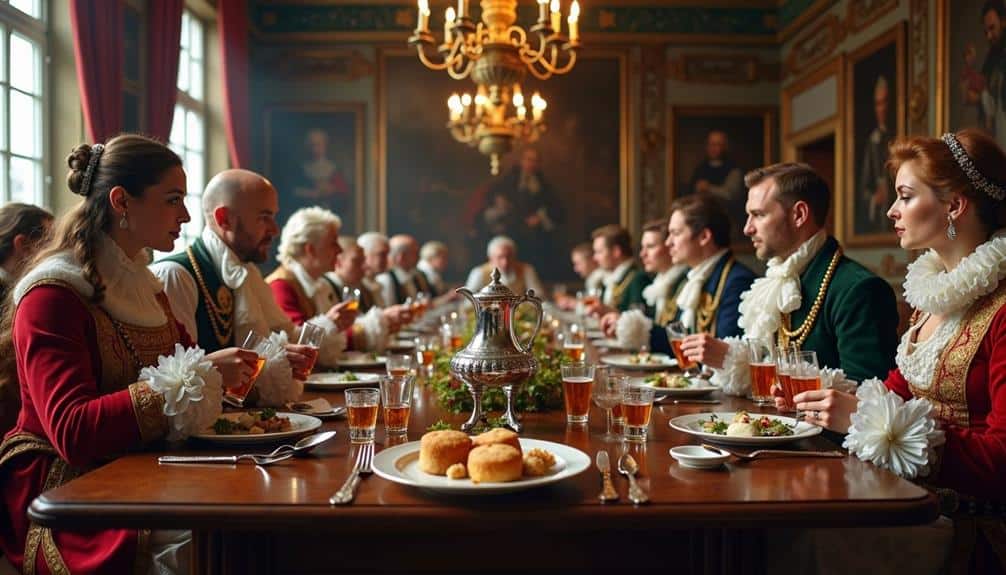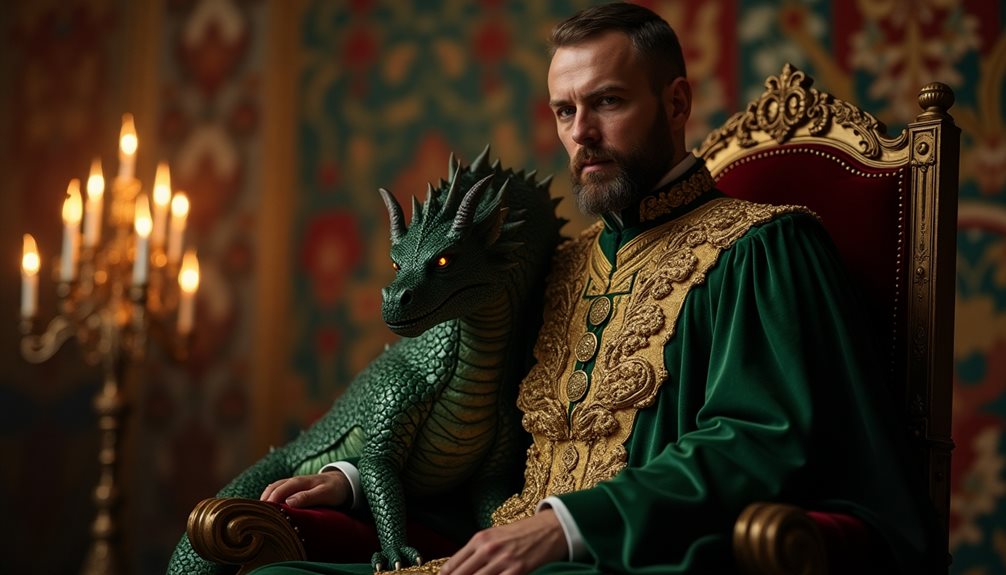When you think about traditional Russian beverages, kvass might not be the first that comes to mind, but its rich history and cultural significance are hard to ignore. Originating over a thousand years ago, kvass started as a humble “bread drink” enjoyed by all social classes. Its evolution from a simple staple to a symbol of hospitality and community showcases its unique role in Russian life. What’s intriguing is how the fermentation process not only enhances its flavor but also offers various health benefits. Curious about how this ancient brew connects generations and reflects Russia’s enduring spirit?
Origins of Kvass

Dating back over a thousand years, the origins of kvass are deeply rooted in Eastern European history, particularly in Russia, where it became a staple of daily life. The fermentation process, central to kvass’s creation, involves the natural conversion of sugars from rye bread into alcohol and carbon dioxide by yeast and lactic acid bacteria. This low-alcoholic beverage, often considered a “bread drink,” exemplifies the ingenuity of early societies in preserving and enhancing their food resources.
Understanding the regional varieties of kvass reveals its adaptability and cultural significance. In Russia, the basic recipe might include ingredients like rye bread, malt, and occasionally fruits or herbs to diversify flavors. In neighboring countries, variations emerge, reflecting local tastes and available resources.
For example, in Ukraine, you might find kvass with added beetroot for a distinct twist, while in Lithuania, honey might be a common addition.
The widespread presence of kvass throughout Eastern Europe underscores its importance. Each regional variety not only offers unique flavors but also tells a story of local customs and agricultural practices.
Early Uses in Russia
Kvass wasn’t just an invigorating beverage in early Russian society; it played a multifaceted role in daily life. Initially, kvass served as a dietary staple, providing essential nutrients through its fermentation process. This process not only preserved the drink but also enhanced its nutritional value, making it an important source of vitamins and probiotics, vital for maintaining health, especially in harsh climates.
You’d find that kvass was deeply embedded in social and religious practices. It was commonly used in rituals and celebrations, symbolizing hospitality and unity. The drink’s accessibility meant it was consumed by all social classes, from peasants to nobility, highlighting its universal appeal.
Regional variations of kvass were notable, reflecting local ingredients and brewing techniques. For instance, in northern regions, the drink might’ve a stronger, more robust flavor, while in southern areas, it could be lighter and sweeter. These variations enriched the cultural tapestry of Russia, offering a glimpse into the diverse culinary practices across the vast nation.
In essence, kvass wasn’t merely a refreshment; it was a cultural artifact, playing a significant role in the social, nutritional, and regional identity of early Russian communities.
Ingredients and Preparation

The allure of kvass lies not only in its historical significance but also in its unique ingredients and meticulous preparation process. At its core, kvass is made from rye bread, water, and a fermenting agent like yeast. The choice of rye bread is essential; it imparts the characteristic dark color and robust, earthy flavor.
You’ll start by drying and toasting the bread, which enhances its complexity. Once you’ve prepared the bread, it’s combined with water and allowed to steep. This mixture undergoes a fermentation process, typically with the addition of malt and sugar to expedite fermentation.
Yeast is vital here, converting sugars into alcohol and carbon dioxide, bringing the kvass to life. The fermentation process usually spans several days, during which the liquid transforms into a lightly effervescent beverage with a low alcohol content.
Flavor variations are achieved by incorporating ingredients like fruits, berries, or honey. These additions not only augment the taste profile but also introduce subtle nuances.
Kvass in Medieval Times
Understanding the intricate preparation of kvass sets the stage for exploring its historical context. In medieval times, kvass was more than just a beverage; it was a crucial part of daily life and social fabric. You’d find kvass in nearly every household, brewed from simple ingredients like rye bread, water, and natural fermenting agents. This made it accessible to all social strata, from peasants to merchants.
Medieval consumption of kvass wasn’t limited to mere sustenance. It played a significant role in social gatherings, such as communal feasts and religious festivals. Kvass was often consumed in large quantities, especially during times of celebration and communal work, enhancing its status as a unifying element among people.
Its mildly alcoholic content made it a safer alternative to often-contaminated water sources, further cementing its place in everyday life.
Furthermore, kvass held medicinal value due to its probiotic nature, believed to aid digestion and boost overall health. In a period where medical knowledge was rudimentary, such attributes made kvass indispensable.
Kvass and Russian Nobility

Among the Russian nobility, kvass assumed a distinctive role that transcended its humble origins. While it began as a common folk beverage, kvass evolved to cater to the nobility’s preferences, becoming an integral part of their daily life and royal celebrations. The aristocracy appreciated kvass not only for its invigorating qualities but also for its reputed health benefits, which ranged from improved digestion to enhanced liveliness.
You’d be intrigued to learn how the nobility favored more refined versions of kvass, often enriched with fruits, berries, and honey, thereby distinguishing their consumption from that of the peasantry. These luxurious variations reflected their elevated status and sophisticated tastes. During royal celebrations, kvass was ceremoniously served alongside more exotic imports, symbolizing a bridge between traditional Russian values and the cosmopolitan influences that permeated the court.
Moreover, the production of kvass within noble households became an art form. Skilled brewers, often employed exclusively by noble families, meticulously crafted recipes that were passed down through generations. This practice not only guaranteed the beverage’s quality but also underscored its significance in aristocratic culture.
Consequently, kvass’s presence in the nobility’s daily life and festivities encapsulates a fascinating blend of tradition, prestige, and cultural identity.
Kvass in Soviet Era
During the Soviet era, kvass experienced a transformation that mirrored the broader societal changes of the time. You’d find that kvass became more than just a traditional beverage; it was a tool of Soviet propaganda, symbolizing unity and collective identity. Authorities emphasized its accessibility, promoting kvass as a drink for the proletariat, aligning with the ideology of equality.
In urban areas, kvass carts became ubiquitous, serving as focal points for communal gatherings. These mobile vendors not only provided an invigorating drink but also facilitated social interactions, reinforcing the concept of collective life. The communal aspect of kvass consumption was pivotal in fostering a sense of community, mirroring the broader goals of the Soviet administration.
Moreover, the state-controlled production processes guaranteed standardization, making kvass a consistent and reliable beverage across the vast Soviet Union. This standardization was another reflection of the era’s emphasis on uniformity and control.
Modern Kvass Production

Modern kvass production has seen significant advancements and diversification, reflecting both technological innovations and evolving consumer preferences.
You’ll find that today’s kvass industry is a vibrant blend of traditional methods and modern techniques. Craft kvass production has surged, with small breweries experimenting with unique flavors and organic ingredients, appealing to a niche market that values authenticity and artisanal quality. This movement towards craft production mirrors global trends in the food and beverage sector, where consumers increasingly seek products with a distinct, handcrafted appeal.
Simultaneously, commercial kvass brands have expanded their reach, leveraging advancements in production technology to guarantee consistency, quality, and scalability. These brands often employ sophisticated brewing equipment and rigorous quality control measures, making kvass more accessible to a broad audience.
Additionally, commercial brands have diversified their product lines, introducing variations like fruit-infused kvass and low-sugar options to cater to health-conscious consumers.
The interplay between craft and commercial kvass production underscores a dynamic industry adapting to contemporary tastes while maintaining a connection to its historical roots.
This dual approach not only preserves kvass’s cultural heritage but also secures its place in the modern beverage market, ensuring its continued relevance and popularity.
Kvass in Popular Culture
As the kvass industry evolves with both artisanal and commercial advancements, its presence in popular culture has grown considerably, reflecting its enduring appeal and cultural significance. You can see kvass featured prominently in Russian literature, film, and music, often symbolizing national identity and traditional values.
The drink’s versatility is evident through a myriad of kvass recipes and kvass variations, ranging from classic rye-based to more innovative fruit-infused versions.
In contemporary media, kvass often appears as a nostalgic element, evoking a sense of heritage. For example, in Russian films and television shows, characters might be seen sharing kvass during family gatherings or festive occasions, underscoring communal bonds.
Likewise, modern literature frequently references kvass, using it as a cultural touchstone that connects past traditions with present-day life.
Social media has also played a pivotal role in kvass’s resurgence. Influencers and chefs share unique kvass recipes, encouraging a global audience to explore this traditional beverage.
Artisanal brands and microbreweries experiment with kvass variations, appealing to both purists and those seeking new flavors. By embracing both its historical roots and contemporary innovations, kvass continues to captivate and engage diverse audiences.
Health Benefits of Kvass

When exploring the health benefits of kvass, you’ll find that this traditional Russian beverage offers a wealth of advantages. The fermentation process is central to kvass’s nutritional value. As a result of this process, beneficial bacteria, known as probiotics, proliferate.
These probiotics play an essential role in promoting gut health by balancing your intestinal flora, which can enhance digestion and bolster your immune system.
Additionally, kvass is rich in vitamins and minerals, such as B vitamins, which are vital for energy production and maintaining healthy neurological functions. The drink also contains antioxidants that help combat oxidative stress, reducing the risk of chronic diseases.
The lactic acid produced during fermentation can improve nutrient absorption and may contribute to a healthier metabolic profile. Furthermore, kvass’s low alcohol content and low calorie count make it a suitable option for those seeking a nutritious yet invigorating drink without the drawbacks of high-calorie beverages.
In essence, kvass exemplifies how traditional practices can yield significant health benefits. Its fermentation process not only enhances its nutritional value but also contributes to overall well-being, making it a valuable addition to your dietary repertoire.
Kvass in Russian Festivals
Kvass holds a prominent place in Russian festivals, weaving together cultural significance and communal joy. During Maslenitsa, the week-long celebration marking the end of winter, families and friends gather to share traditional foods, including kvass.
You’ll find that kvass recipes vary, with some households passing down unique blends through generations, each imbued with its distinct flavor and history.
In the context of religious festivals, kvass rituals are equally integral. For instance, during Easter, kvass is often blessed by priests and used in toasts that celebrate resurrection and renewal. This practice highlights the drink’s sacred role, transcending mere refreshment to symbolize spiritual and communal unity.
Moreover, at harvest festivals such as Kupala Night, kvass serves as a bridge between the past and present. You’ll notice that the preparation and sharing of kvass foster a collective memory, reinforcing cultural continuity.
By engaging in these kvass rituals, participants honor their heritage while creating new memories.
Understanding kvass in Russian festivals reveals its multifaceted role. It’s not just a beverage; it’s a vessel of tradition, a symbol of togetherness, and a representation of the enduring spirit of Russian cultural celebrations.
Conclusion
You’ve journeyed through the rich tapestry of kvass, from its ancient origins to its modern-day significance. This traditional Russian beverage isn’t just a drink; it’s a cultural emblem that bridges the past and present. By understanding kvass’s historical evolution, preparation methods, and role in society, you gain a deeper appreciation for its enduring legacy. Kvass stands as a symbol of Russia’s cultural resilience, offering both a flavorful experience and a connection to centuries-old traditions.




